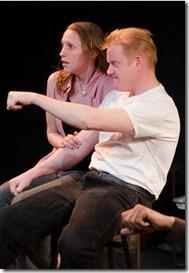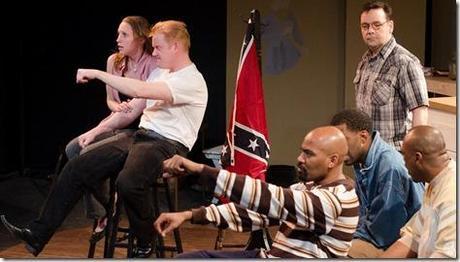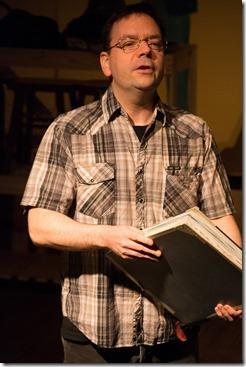
Confederates in the Attic
Written by Tony Horwitz
Adapted and Directed by Terry McCabe
at City Lit Theater, 1020 W. Bryn Mawr (map)
thru May 25 | tickets: $29 | more info
Check for half-price tickets
Read review
Richly adapted and faithfully staged

City Lit Theater presents
Confederates in the Attic
Review by Lawrence Bommer
The third installment in City Lit’s salute to the Civil War’s 150th anniversary, Confederates in the Attic is not, like its predecessors, set in the past. Adapted from Tony Horwitz’ non-fiction best seller, it looks, humorously and non-judgmentally, at a war that, at least in the South, never really ended. If Freud said that “An unfinished task is never forgotten,” in Dixie yesterday and its “glorious Lost Cause” in the “War of Northern Aggression” is today (just as the Crusades are in today’s Middle East). You can call these C.S.A. descendants sore losers but, in his exploration of battlefield re-enactors and their perverse purity to 10th century campground misery and of Southerners who wax nostalgic for slavery and plantations, twenty years ago Horwitz found a lot of unfinished business that still divided this united Union.

Sometimes this longing for the ante-bellum era and the early battles when Lee was beating the Union boys right and left is just an excuse for dressing-up and make-believe. Horwitz (an open-eyed Kevin Gladish) is taken into the inner circles of the “Civil War bums” who recreate battles (“Civil Wargasms”) to get a “period rush” of authenticity and borrowed bravery. His guide is the obviously named Robert Lee Lodge (an affable Peter Goldsmith), a “hard core” hardscrabble simulator—or “historical interpreter”–who instructs this “honorary cracker” on how to piss on buttons to get them to look right; eat hardtack and salt pork or, better, nothing at all so you look like a starved perckerwood warrior (135 lbs. is the ideal weight); never carry plastic, bathe or wear zippers; and die in the right order and manner.
Horwitz’ travels take him through the Blue Ridge Mountains to numerous battlefields of 15 states, especially northerrn Virginia — Ft. Sumter, Antietam (where they spend all night illegally sleeping in the “Bloody Lane” of the sunken road where hundreds perished), Petersburg, The Wilderness, Spotsylvania, Richmond, Vicksburg, Chancellorsville, and Appomattox. Inevitably, they pay a pilgrimage to pivotal Gettysburg circa 1863 where they imagine Pickett’s Charge and its eternal “moment of no return,” complete with death march accompanied by rebel yells (three kinds of which are ferociously demonstrated) that greeted Longstreet’s bluecoats. Alas, many of these supposedly sacred sites have been desecrated by strip malls or tourist traps.
Multiple narrators from the impressive and well-cast 14-member cast describe the tragedy of Michael Westerman (Christian Isely), a punk white teenager shot by black kids for flying the Confederate flag from his pickup truck (a banner that they thought was something out of “Dukes of Hazzard”). Horwitz testifies to K.K.K. rallies in Kentucky, hateful white-supremacist incitements to race war to preserve an “Aryan nation.” Horwitz talks to African-Americans, like Freddie Morrow (Johnathan Wallace), who shot Westerman for reasons he can’t ken. These fellow-Southerners dismiss the white boys’ blasts from the past as harmless, empty posturing or see them as proof of Southern amnesia about their “peculiar institution.” Then there are the “United Daughters of the Confederacy,” who wear crinoline at debutante balls or widows’ bombazine at restaged battles: These too retroactively preserve a privilege bought from blood. As a Jew, Horwitz speculates about how 3,000 of his fellow-religionists could fight for slavery, conveniently forgetting what happened in Egypt. Horwitz concludes with William Faulkner’s powerful contemplation of how Pickett’s Georgia boys turned the wrong tide on the last day at Gettysburg.
A kind of volatile but compassionate mix of “Deliverance,” “The Killer Angels,” and “Gone with the Wind,” Horwitz’ travels reveal a still divided nation, as distrustful of government as in 1861 and who just can’t “get over it.” Some admit that it was really a rich man’s war, even that chattel bondage was a sin and would have been abandoned eventually. (It took Brazil until the 1890s to abolish slavery.) But they cling to the Cavalier-like legends of gallantry in combat and the fantasy of sipping mint juleps under colonnades flanked by moss and dogwood. Yet propaganda is always political and, to his credit, Horwitz does not minimize the unhealed wounds that fester a century and a half later.
The big question Horwitz asks remains unanswered: How can white Southerners properly commemorate the sacrifices of their ancestors in a cause whose reasons were discredited long ago? How indeed? Maybe, as this cunning play presents, by process of elimination…
Rating: ★★★
Confederates in the Attic continues through May 25th at City Lit Theater, 1020 W. Bryn Mawr (map), with performances Fridays at 7:30pm, Saturdays 3pm, Sundays 2pm. Tickets are $29, and are available online through BrownPaperTickets.com (check for half-price tickets at Goldstar.com). More information at CityLit.org. (Running time: 2 hours 10 minutes, includes an intermission)
Photos by Tom McGrath
artists
cast
Nick Ferrin (Walt, others), Kevin Gladish (Tony Horwitz), Peter Goldsmith (Robert Lee Hodge), Varris Holmes (Sumter Ranger), Christian Isely (Michael Westerman, others), Liz Krane (Sue Curtis, others), Adrienne Matzen (Geraldine, others), Christopher McMorris (Rev. Michael King, others), Charles Schoenherr (Joel Dorfman, others), Megan Skord-Campbell (Caroline, others), La’ren Vernea (Rose Mary Sanders, others), Evan Voboril (Abe Stice, others), Johnathan Wallace (Freddie Morrow, others), Freddy Lynn Wilson (Jimmy Olgers, others)
behind the scenes
Terry McCabe (director, adaptor), Devin Carroll (lighting design), kClare Kemock (costume design), Dustin Pettegrew (scenic design), Tom McGrath (photos)
14-0522

